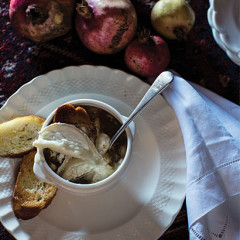You’d think that that for someone who uses stock as much as I do, I’d long ago have made a plan to cook some of my own from scratch. But alas, I’m a lazy so-and-so and have, up until yesterday, always depended on the expertise of the folk behind the ready-made stocks available at stores. What better way to force myself to make stock, then, than to have someone suggest it as a topic during one of our team’s editorial meetings?
Truth be told, there’s nothing quite like a looming deadline to motivate you to tackle a laborious task. And so, I found myself moseying down to my local butcher during my lunch hour yesterday. I managed to catch the butcher’s eye, saying: “Just getting some bones for stock” (feeling quite virtuous while saying this, I might add). “You know we sell our own stock here, don’t you?” he replied, and, before I could get another word in, he added, “Ah, you want to do things old school.” And then, yes, I let him believe that I’m the kind of person who regularly makes her own stock from scratch, along with brewing my own beer and growing my own produce.
Paying for my loot at the till I asked him: “So, any tips?” He recommended roasting the bones, adding root vegetables, hardy herbs and a bit of vinegar. “Great, thanks,” I said, making a mental note to get some hardy herbs at the shops.
I eventually stumbled out of the office at around six, not exactly thrilled at the prospect of nursing a pot of bubbling stock into the wee hours of the morning. First thing through the door, I banged the bones onto a roasting tray and popped them in the oven. Online sources said varying things about how long said roasting should take, so I played it by ear and took them out once they were smelling nice and meaty and the fat had started rendering at the bottom of the pan.
Next, I put the bones in my largest pot (pretty average-sized, actually), along with chopped carrot, onion, garlic, rosemary, thyme, a splash of red wine vinegar and water. Oh, and salt. Salt is important. I brought the lot to the boil, then turned it down to a simmer and set my timer for five hours.
Another thing the butcher said was to constantly skim the scum off the surface of the stock while it’s cooking. Let’s pretend I interrupted my valuable series-watching time by doing this every half hour. See, the way I did it, there was almost zero effort involved in making the stock, apart from dipping my spoon in the bubbling liquid every now and then to check the progress of the developing flavour.
At around eleven o’clock, there was still one hour to go. I tasted the stock, my fiancé tasted the stock. It had already developed quite an intoxicating beefy, slightly sweet taste and an intriguing, murky brown colour. Sure, another hour would have intensified the flavour even further, but I was pooped. So this is what it’s like to make your own stock, I thought to myself. And then I called it a day.






Comments